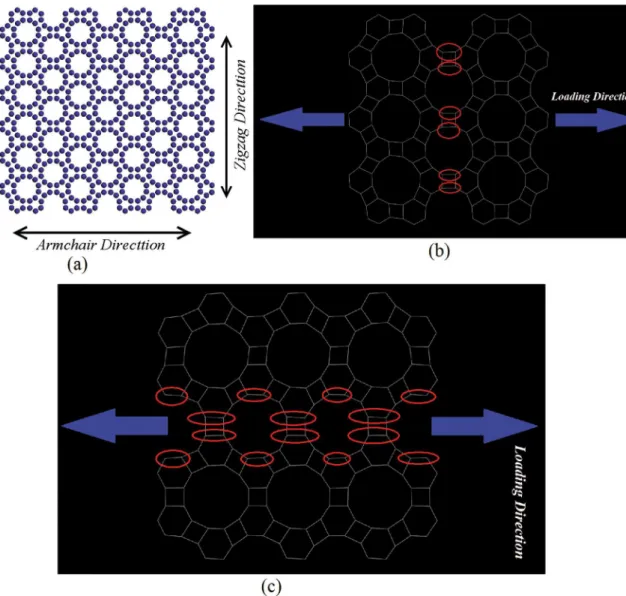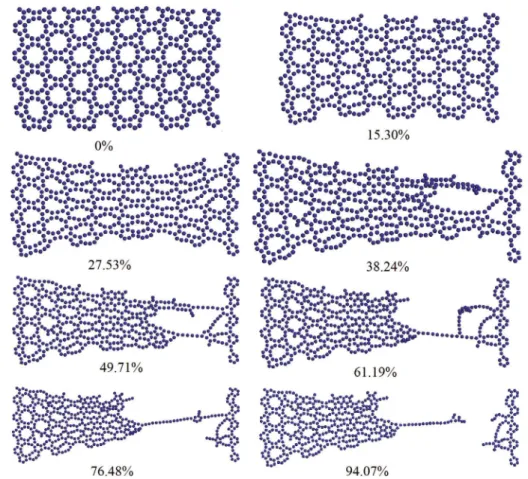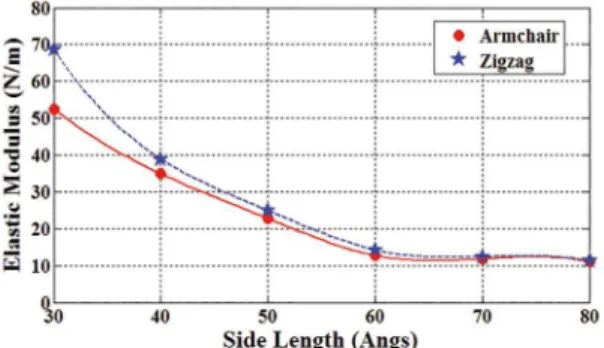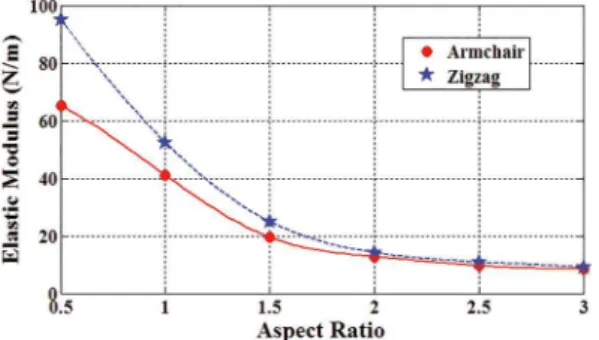Investigation of the Elastic Properties of Graphenylene Using Molecular Dynamics
Simulations
Saeed Rouhia*, Ali Ghasemib
Received: December 6, 2015; Revised: September 6, 2016; Accepted: October 20, 2016
Molecular dynamics simulations are used here to study the mechanical behavior of graphenylene
under uni-directional and bi-directional loadings. The efects of nanosheet chirality and size on Young’s
modulus of graphenylene are investigated. Compared to graphene, graphenylene possess a smaller
elastic modulus. It is shown that for large armchair and zigzag graphenylenes, the efect of nanosheet size on the mechanical properties can be neglected. It is observed that increasing temperature results in decreasing Young’s modulus of graphenylene. Besides, fracture of graphenylene occurs at large strains. Moreover, it is represented that for small graphenylenes, bulk modulus is signiicantly sensitive to the size variation. However, this sensitivity disappears for large nanosheets.
Keywords: Molecular dynamics simulations, Graphenylene, Young’s modulus, Bulk modulus
* e-mail: s_rouhi@iaul.ac.ir
1. Introduction
Since the discovery of graphene by Novoselov et al. in 20041, this carbon allotrope has attracted the attention of
many researchers. This can be attributed to its great physical, chemical, and mechanical properties1-3. Due to these great
properties, graphene has found potential applications in several areas such as nanoelectronics, sensors, transistors, batteries, as well as polymer composites4-6.
Caused by these vast potential applications of graphene
and carbon nanotubes (CNTs) in addition to various hybridized
states of carbon (sp, sp2, and sp3), many researchers have
devoted their investigations on inding other carbon allotropes
which can possess extraordinary physical properties7-13.
Graphenylene which was irst described by Balaban et al.14 is
one of these allotropes that some of the research works have investigated its properties15-23.The structure of graphenylene
(so-called biphenylene carbon (BPC)) has been theoretically
predicted24-26 and synthesized27.
Recently, Song et al.22 studied the properties of graphenylene
as the irst example of a non-delocalized sp2-carbon structure. They
showed that graphenylene has periodic pores with the diameters
of 3.2 Å. Besides, it was claimed that it is a semiconductor with
a narrow direct band gap which leads to its applicability in
electronic devices and eicient hydrogen separation. Using ab initio density functional theory (DFT) calculations, Yu23 illustrated
that graphenylene can store lithium with great density of energy.
He showed that graphenylene can adsorb a lithium atom stronger than pristine graphene. Hankel and Searles28 showed that the
lithium storage capacity of graphenylene is larger than graphite. Andrew T. Koch et al.29 used DFT and tight-binding methods to
investigate the graphenylene based nanotubes.
Mechanical properties of graphenylene are studied here by employing molecular dynamics (MD) simulations.
To this end, the efect of some parameters such as chirality and size on Young’s and bulk moduli of graphenylene are investigated. Besides, the fracture process of armchair and zigzag nanosheets under uni-directional and bi-directional
tensions are explored.
2. Models
The structure of a sample graphenylene is shown in
Figure 1. To obtain Young’s modulus of graphenylene, the
loads are applied in two directions, namely armchair and
zigzag, which are shown schematically in Figure 1. As it is seen in Fig 1(b) and (c), for zigzag graphenylene, more
C-C bonds are directed along the loading direction (the ellipses have been used to show the directed bonds along the loading direction).
3. Simulation method
To obtain the mechanical properties of graphenylene,
MD simulations are performed by LAMMPS MD code30,31.
To deine the interactions between the carbon atoms in the
structure of graphenylene, Adaptive Intermolecular Reactive
Empirical Bond Order (AIREBO) potential function32 is
employed. This potential function is the improved version of
Brenner’s second-generation reactive empirical bond order
potential33 in which the Lennard-Jones term has been added
to include van der Waals interactions. Moreover, torsional
term is included to consider torsions of σ bonds. So it is anticipated to give more accurate results than Brenner’s
a Young Researchers and Elite Club, Langarud Branch, Islamic Azad University, Langarud, Guilan, Iran
b Department of Mechanical Engineering, Faculty of Engineering, Tehran North Branch, Islamic Azad
Rouhi et al.
2 Materials Research
Figure 1: (a) Schematic of graphenylene with the armchair and zigzag direction, (b) Loading direction and C-C bonds detected along the loading direction for armchair and (c) zigzag nanosheets
potential function.After initial minimization of the system
energy, the systems are relaxed for 20ps with the timestep of
1fs. For integration the equations of motion, velocity Verlet
algorithm is utilized.
4. Results and discussion
To study the efect of atomic structure on the mechanical properties of graphenylene, armchair and zigzag nanosheets are modeled here. Moreover, considering diferent side lengths (a) and widths (b), the efect of graphenylene geometry on the
mechanical properties are studied. Figure 2 shows armchair
and zigzag nanosheets with the corresponding geometrical
parameters. The loads are applied on the upper and lower edges of nanosheets. In each loading step, the boundary atoms are displaced and then the systems are let to relax for 2ps (2000 steps with the time step of 1fs). So, the stress
would be distributed all over the nanosheets and the quasi-static condition of the tensile tests are simulated. All of the simulations are performed under NVT (constant number of molecules, constant volume, and constant temperature)
ensemble. Besides, to ensure the stability of the simulations, Nose–Hoover thermostat is employed here.
4.1. Young’s modulus
To obtain the mechanical properties of graphenylene,
the lower sides of the nanosheets are ixed and upper sides
are displaced incrementally. In each step, the strain and the system energy are recorded. As a unique value has not been reported for the thickness of nanostructures34-37, the in-plane
Young’s modulus is used here which is obtained as38:
( )
Y A
E
1 1
S
S
0 2
2
2 2
f
Figure 2: (a) Armchair and (b) zigzag graphenylene with the corresponding geometrical parameters
whereES, A0 and ε are strain energy of system, initial
unit cell area and strain, respectively. The recorded strain
energies of armchair and zigzag graphenylenes with
the dimensions of 30×50 Å2are shown in Figs. 3 and 4
against strain. The drops of the curves show the bond breakages. As it is seen, the fracture occurs in different steps. In each step, some of the bonds break.This fact can be verified with the graphs of temperature versus strain which are shown in Figs. 5 and 6. As it is seen, each bond breakage results in a pick in the temperature of the systems.
The gradual breakage of the armchair and zigzag
nanosheets are also represented in Figs. 7 and 8. It is seen that in each fracture step, some of the bonds are broken down. Finally, by connecting the cut bonds, a line of atoms is formed and stretched. For both of the nanosheets, the boundary effect is clearly seen. For armchair graphenylene, this effect results in breakage near
the end of nanosheet. However, for zigzag graphenylene,
although the some of the bonds near the left boundary are broken, the final fracture occurs at the middle of nanosheet. Moreover, comparing the figures at different steps, one can conclude that at each step, by breaking some bonds, some other new bonds are formed. The large fracture strain of graphenylene can be attributed to the formation of these new bonds.
Figure 9 depicts in-plane Young’s moduli of armchair and zigzag graphenylenes with the aspect ratio of 1.5 versus nanosheet side length. The sizes of the considered
nanosheets are given in Table 1. Since the dimensions can not be completely equal, the closest dimensions
Figure 3: Strain energy of a 30×50 Å2 armchair graphenylene
versus strain
Figure 4: Strain energy of a 30×50 Å2 zigzag graphenylene versus
strain.
are considered. As it is seen at a same size, zigzag
graphenylenes have larger elastic modulus than armchair
ones. However, the difference can be neglected for side lengths larger than 50Å. Besides, increasing side
Rouhi et al.
4 Materials Research
Figure 5: Temperature of a 30×50 Å2 armchair graphenylene
versus strain.
Figure 6: Temperature of a 30×50 Å2 zigzag graphenylene versus strain
Figure 7: The shapes of a 30×50 Å2 armchair graphenylene at diferent strains
in decreasing the elastic modulus. The effect of side length on the elastic modulus also disappears for the side lengths larger than 60Å.
Represented in Figure 10 are in-plane Young’s moduli of armchair and zigzag graphenylene with the side length of 50 Å versus graphenylene aspect ratio. The exact sizes
of the considered nanosheets are given in Table 2. As the previous figure, it is seen that increasing aspect ratio of
the nanosheets results in decreasing Young’s modulus. Both of the effects of aspect ratio and chirality (being armchair and zigzag) diminishes for the aspect ratios
larger than 2.
Young’s moduli of 30×50 Å2 armchair and zigzag
graphenylenes are obtained as 68.31 N/m and 79.42 N/m,
respectively, which are approximately 25% of Young’s
modulus of graphene (272 N/m). The ultimate strength of
armchair and zigzag 30×50Å2 graphenylenes are 429.43nN
and 1140.59nN, respectively. Comparing these values with the ultimate strength of graphene (1070 nN), it is seen that while the ultimate strength of armchair graphenylene is
40% of graphene, zigzag graphenyle has a larger ultimate strength than graphene. Besides, the large diference between the ultimate strength of armchair and zigzag nanosheet is
Figure 8: The shapes of a 30×50 Å2 zigzag graphenylene at diferent strains
Figure 9: In-plane Young’s modulus of armchair and zigzag
graphenylenes with the aspect ratio of 1.5 versus graphenylene side length.
The yield and ultimate strains of 30×50 Å2 armchair
graphenylene are obtained as 14.43% and 94.46%,
respectively. These values are 15.43% and 101.26% for
zigzag graphenylene. Note to the large ultimate strains of armchair and zigzag graphenylene which were shown schematically in Figs. 7 and 8. Poisson’s ratio of armchair and zigzag graphenylenes were obtained as 55% and 73%, respectively which are smaller than Poisson’s ratio of
graphene (approximately 88%).
The efect of temperature on the elastic modulus of
the grapheneylene is given in Figure 11 for a 40×60 Å2
armchair nanosheet. Unlike Figs. 10 and 11 in which the
dependence of the grapheneylene elastic modulus to the nanosheet side length and aspect ratio were investigated, no uniform behavior is observed by increasing the temperature. Therefore, a linear interpolation is used to view the general trace of the graphenylene elastic modulus by time variation. It is observed that nanosheets possess
Rouhi et al.
6 Materials Research
Table 1: Dimensions of armchair and zigzag nanosheets with the
aspect ratio of 1.5
Zigzag Armchair
32.4594×46.0895 Å2 30.4195×45.3500 Å2
39.4964×60.1915 Å2 40.5600×61.7264 Å2
51.2034×75.0935 Å2 50.1530×74.6174 Å2
61.7264×90.0300 Å2 60.1915×90.9934 Å2
73.4332×105.5130 Å2 70.4330×103.8850 Å2
80.4710×120.4495 Å2 80.4715×120.2604 Å2
Figure 10: In-plane Young’s modulus of armchair and zigzag
graphenylenes with the side length of 50 Å versus graphenylene aspect ratio.
Table 2: Dimensions of armchair and zigzag nanosheets with the
aspect side length of 50 Å
Zigzag Armchair
51.2034×25.8095Å2 50.1530×26.6060Å2
51.2034×50.1530Å2 50.1530×51.2034Å2
51.2034×75.0935Å2 50.1530×74.6174Å2
51.2034×100.1695Å2 50.1530×102.7002Å2
51.2034×125.0595Å2 50.1530×126.1138Å2
51.2034×150.8700Å2 50.1530×150.7130Å2
Figure 11: Efect of temperature on the elastic modulus of the
grapheneylene for a 40×60 Å2 armchair nanosheet.
( )
B
A
A
E
2
S 0 2 22
2
=
T
Y
be said that increasing the temperature results in higher kinetic energies of the atoms of nanosheets which results in smaller strength of nanosheets.
4.2. Bulk modulus
Bulk moduli of graphenylene are computed by bi-directional loading on nanosheets. Here, one horizontal edge and one
vertical edge are constrained and the loads are applied in the form of displacement to the opposite edges. The following relation can be used to obtain the nanosheet bulk modulus:
in which
A
is the nanosheet area. The conigurations of a 50×50 Å2 graphenylene under bi-directional loading atdiferent timesteps are given in Figure 12. It is seen that the
fracture initiates at the corners of the nanosheet and then propagates linearly parallel to the graphenylene boundaries. Linear propagation of fracture leads to breaking some bonds and formation some new bonds. Interestingly, bond breakage and formation of new bonds happen in the center of the
nanosheet which is not in the fracture region. Besides, the fracture happens perpendicular to the zigzag direction and
near the graphenylene boundary.
The computed bulk moduli of square graphenylenes
with diferent side lengths are given in Figure 13. Table 3 represents the exact sizes of the selected nanosheets.It is seen that the efect of side length on the graphenylene bulk moduli is signiicant at the small side lengths. However, after 100Å, the graph take a linear form and the efect of graphenylene size on the bulk modulus can be neglected.
5. Conclusions
Employing MD simulations, mechanical properties of graphenylene were computed. Applying unidirectional
displacement on the armchair and zigzag graphenylene, Young’s moduli of nanosheets with diferent sizes were obtained. It was shown that at a same size, zigzag graphenylenes possess larger Young’s moduli than armchair. The efect of chirality
was disappeared for large graphenylenes. Tracking the fracture
process of armchair and zigzag graphenylenes, it was seen that the fracture happens at diferent steps in each of them
some bonds are destroyed and some new ones are created.
The boundary efect was observed for all unidirectional and
Figure 12: The shapes of a 50×50 Å2 graphenylene under bi-directional loading at diferent strains
Figure 13: Computed bulk moduli of square graphenylenes with
diferent side lengths
Table 3: Dimensions of selected nanosheets for investigation the bulk modulus
26.6060×25.8095 Å2
51.2034×50.1530 Å2
74.6174×75.0935 Å2
102.7002×100.1695 Å2
126.1138×125.0595 Å2
Rouhi et al.
8 Materials Research
6. References
1. Novoselov KS, Geim AK, Morozov SV, Jiang D, Zhang Y, Dubonos SV, et al. Electric Field Efect in Atomically Thin
Carbon Films. Science. 2004;306(5696):666-669.
2. Novoselov KS, Geim AK, Morozov SV, Jiang D, Katsnelson
MI, Grigorieva IV, et al. Two-dimensional gas of massless Dirac fermions in graphene. Nature. 2005;438:197-200.
3. Ferrari AC, Meyer JC, Scardaci V, Casiraghi C, Lazzeri M,
Mauri F, et al. Raman spectrum of graphene and graphene layers. Physics Review Letters. 2006;97(18):187401.
4. Novoselov KS, Jiang D, Schedin F, Booth TJ, Khotkevich VV, Morozov SV, et al. Two-dimensional atomic crystals. Proceedings of the National Academy of Sciences of the United States of America. 2005;102(30):10451-10453.
5. Geim AK, Novoselov KS. The rise of graphene. Nature Materials. 2007;6:183-191.
6. Mohanty N, Berry V. Graphene-based single-bacterium
resolution biodevice and DNA transistor: interfacing graphene derivatives with nanoscale and microscale biocomponents.
Nano Letters. 2008;8(12):4469-4476.
7. Kroto HW, Heath JR, O’Brien SC, Curl RF, Smalley RE. C60: Buckminsterfullerene.Nature. 1985;318:162-163.
8. Kong XY, Ding Y, Yang R, Wang ZL. Single-Crystal Nanorings Formed by Epitaxial Self-Coiling of Polar Nanobelts. Science. 2004;303(5662):1348-1351.
9. Narita N, Nagai S, Suzuki S, Nakao K. Optimized geometries
and electronic structures of graphyne and its family. Physical Review B. 1998;58(16):11009.
10. Narita N, Nagai S, Suzuki S, Nakao K. Electronic structure
of three-dimensional graphyne. Physical Review B. 2000;62(16):11146.
11. Narita N, Nagai S, Suzuki S. Potassium intercalated graphyne. Physical Review B. 2001;64(24):245408.
12. Sheng XL, Yan QB, Ye F, Zheng QR, Su G. T-carbon: a novel
carbon allotrope. PhysicalReview Letters. 2011;106(15):155703.
13. Minyaev RM, Avakyan VE. Supertetrahedrane—A new possible carbon allotrope. DokladyChemistry. 2010;434(2):253-256.
14. Balaban AT, Rentea CC, Ciupitu E. Chemical graphs. VI.
Estimation of the relative stability of several planar and tridimensional lattices for elementary carbon. Revue Roumaine de Chimie. 1968;13:231-247.
15. Balaban AT, Vollhardt KPC. Heliphenes and Related Structures. The Open Organic Chemistry Journal. 2011;5:117-126.
16. Balaban AT. Carbon and its nets. Computers & Mathematics with Applications. 1989;17(1-3):397-416.
17. Balaban AT, Klein DJ, Folden CA. Diamond-graphite hybrids. Chemical Physics Letters. 1994;217(3):266-270.
18. Zhu H, Balaban AT, Klein DJ, Živković TP.
Conjugated-circuit computations on two-dimensional carbon networks.
The Journal of Chemical Physics. 1994;101(6):5281-5292.
19. Klein DJ, Balaban AT. Clarology for conjugated carbon nanostructures:
Molecules, polymers, graphene, defected graphene, fractal
benzenoids, fullerenes, nano-tubes, nano-cones, nano-tori, etc. The Open Organic Chemistry Journal. 2011;5(Suppl 1-M3):27-61.
20. Merz KM Jr., Hofmann R, Balaban AT. 3,4-Connected
carbon nets: through-space and through-bond interactions in the solid state. Journal of the American Chemical Society. 1987;109(22):6742-6751.
21. Diercks R, Vollhardt KPC. Tris(benzocyclobutadieno)benzene, the triangular [4]phenylene with a completely bond-ixed cyclohexatriene ring: cobalt-catalyzed synthesis from hexaethynylbenzene and thermal ring opening to
1,2:5,6:9,10-tribenzo-3,4,7,8,11,12-hexadehydro[12]annulene. Journal of the American Chemical Society. 1986;108(11):3150-3152.
22. Song Q, Wang B, Deng K, Feng X, Wagner M, Gale JD, et al.
Graphenylene, a unique two-dimensional carbon network with
nondelocalized cyclohexatriene units. Journal of Materials Chemistry C. 2013;1(1):38-41.
23. Yu YX. Graphenylene: a promising anode material for lithium-ion
batteries with high mobility and storageJournal of Materials Chemistry A. 2013;1(43):13559-13566.
24. Baughman RH, Eckhardt H, Kertesz M. Structure-property
predictions for new planar forms of carbon: Layered phases containing sp2 and sp atoms. The Journal of Chemical Physics.
1987;87(11):6687-6699.
25. Enyashin AN, Ivanovskii AL. Graphene allotropes. Physica Status Solidi (b). 2011;248(8):1879-1883.
26. Brunetto G, Autreto PAS, Machado LD, Santos BI, Santos RPB, Galvão DS. Nonzero Gap Two-Dimensional Carbon Allotrope from Porous Graphene. The Journal of Physical Chemistry C. 2012;116(23):12810-12813.
27. Schulman JM, Disch RL. A Theoretical Study of Large
Planar [N]Phenylenes. The Journal of Physical Chemistry A. 2007;111(39):10010-10014.
28. Hankel M, Searles DJ. Lithium storage on carbon nitride,
graphenylene and inorganic graphenylene.Physical Chemistry Chemical Physics. 2016;18(21):14205-14215.
29. Koch AT, Khoshaman AH, Fan HD, Sawatzky GA, Nojeh A.
Graphenylene Nanotubes. The Journal of Physical Chemistry Letters. 2015;6(19):3982-3987.
30. LAMMPS Molecular Dynamics Simulator. Available from:
<http://lammps.sandia.gov>. Access in: 1/3/2010.
31. Plimpton S. Fast Parallel Algorithms for Short-Range Molecular
Dynamics.Journal of Computational Physics. 1995;117(1):1-19.
32. Stuart SJ, Tutein AB, Harrison JA. A reactive potential for
hydrocarbons with intermolecular interactions. The Journal of Chemical Physics. 2000;112(14):6472-6486.
34. Xin Z, Jianjun Z, Zhong-can OY. Strain energy and Young’s
modulus of single-wall carbon nanotubes calculated from electronic energy-band theory. Physical Review B. 2000;62(20):13692-13696.
35. Tu ZC, Ou-Yang ZC. Single-walled and multiwalled carbon nanotubes viewed as elastic tubes with the efective Young’s
moduli dependent on layer number. Physical Review B. 2002;65(23):233407.
36. Pantano A, Parks DM, Boyce MC. Mechanics of deformation
of single- and multi-wall carbon nanotubes. Journal of the Mechanics and Physics of Solids. 2004;52(4):789-821.
37. Goupalov SV. Continuum model for long-wavelength phonons in two-dimensional graphite and carbon nanotubes. Physical Review B.2005;71(8):085420.





